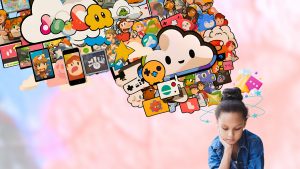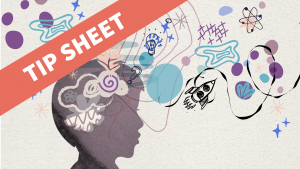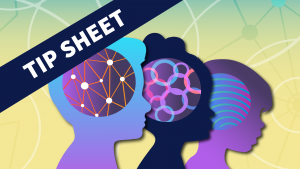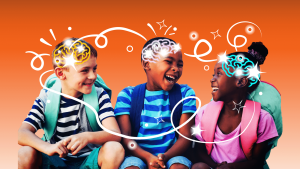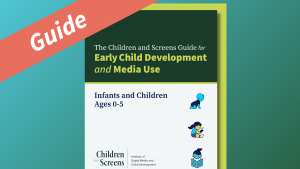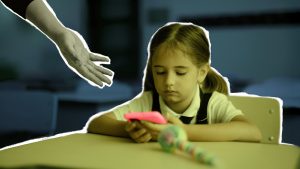
For many of today’s adolescents, digital devices are providing distracting and interruptive notifications hundreds of times a day. Meanwhile, some young children are spending time daily, unmonitored, with “babysitter” iPads. What is known about the short- and long-term effects to attention spans and cognitive functioning for both young children and adolescents from this time spent with digital media? How can parents and caregivers promote optimal attentional health and executive functioning for youth in the digital age?
Attention and Cognitive Development: What to Know
What Is Attention?
“When we talk about paying attention, what we’re really talking about is the skill of controlling our minds. When you pay attention, you are choosing what you think about, what you look at, what your mind focuses on,” says author and journalist Nicholas Carr. This skill of controlling the mind for cognition and the ability to focus and concentrate are key to opening opportunities for a full life in childhood, adolescence, and into adulthood, says Carr.
The “attention network” is a general term for a set of processes necessary for cognitive control, and for learning, language and reading development, that is composed of two main components or systems, says Tzipi Horowitz-Kraus, PhD, Associate Professor, Educational Neuroimaging Group, Faculty of Education in Science and Technology, and Faculty of Biomedical Engineering at Technion – Israel Institute of Technology.
- Attention system – This is the quick-to-respond system, and it is aimed to create alertness when we hear or see something and to orient our attention towards a specific stimulus.
- Executive function system – This system is much slower and is related to processes like memory and error detection.
How Does Attention Develop?
Human beings are naturally distractible and must learn how to pay attention, says Carr. This process starts early in life, as early as birth, and continues in infancy, says Horowitz-Kraus, who notes research indicating that the participation of executive functions during totally passive story listening starts at the age of 18 months.
The involvement of child attention networks continues to increase with age. In the younger child years, the critical work of developing these capacities is achieved by engaging in activities that focus attention and practicing them over and over again, says Carr.
What Does The Research Say About Digital Media Use And Attention?
Research conducted to date appears to support the following conclusions, according to Horowitz-Kraus:
- Screen time is related to less stimulation of executive functions, less reliance on imagination and visualization, more interruptions, and greater attention load.
- Reading from a screen may be less efficient than from print as brain regions used during screen exposure may compete with those used for literacy in reading.
- Neurobiological correlates for attention and cognitive load are observed when performing a simple task in the presence of a smartphone.
More longitudinal studies into long-term effects of digital media use on attention networks are noted, says Horowitz-Kraus.
The “Attention Crisis’ Is A Particular Issue For Children
“By now most of us understand that we’re in something of an ‘attention crisis.’ The reason we understand that is because we feel it individually,” says Carr. “There’s always been lots of distractions going on around us. What’s new is that on top of all those existing distractions, we’ve laid this new environment in which we live, the digital or virtual environment, in which there is no end to new and interesting things.” This is a particular issue for children because their brains are still building the neural networks and skills needed to develop attentiveness.
Executive functioning in the brain acts as “air traffic control” for working memory, prioritizing, organizing, sequencing, managing time and planning, attending, initiating and focusing social-emotional skills around inhibition, as well as communicating cognitive flexibility and shifting, says Taína Coleman, MA, MEd, Educational Specialist, Learning and Development Center at the Child Mind Institute. These skills are necessary to complete tasks and yet one in five children have a learning or attentional challenge that affects executive functioning.
In this digital environment, particularly with our phones, we’ve created something unprecedented, an unprecedented technology in human history that is fundamentally geared to grabbing our attention.

Tips And Considerations For Young Children, Digital Media, And Attention
Be Aware: Screen Time Can Affect Young Children’s Developing Brain Structures
Researchers have found brain structure changes in young children exposed to more screen time at the age of 3 to 5, notes Horowitz-Kraus. These changes include decreased organization of the connections between the attention system, visual processing regions, and language processing regions that are extremely crucial for language processing and academic skills.
Read To Your Young Child – Interactive Is Better Than Passive Storytelling
Children listening to stories are engaging their attention systems. However, “passive screen viewing doesn’t engage attention as much as interactive storytelling,” says Horowitz-Kraus. She cites recent research demonstrating that the inhibitory part of executive function (the ability to control/inhibit responses), as well as some markers related to visual attention (the ability to attend the visual system to relevant stimuli), were extremely and significantly improved in children following dialogic (interactive) reading training. The same research indicated that children listening to stories via a screen showed no effect or improvement on these aspects of the attention network.
Other recent research using functional MRI looked at measuring children’s brain function during an activity. Researchers tested two conditions: a person telling a story to a child via a screen with pages and audio recording and another condition where the children were watching a movie. Both conditions were matched for difficulty of content and illustration level. “We were very surprised to see that when children were watching basically something that was similar to a book reading, pictures with audio, they engaged their attention system and their visual system much more, as opposed to a condition of watching a video,” says Horowitz-Kraus.
Even though watching a video is more triggering and stimulating to the visual system, it is nevertheless less engaging as found by the functional MRI. Horowitz-Kraus posits that the nature of video watching keeps the young brain passive as opposed to the imagination and attention allocation demanded by listening to a story.
Encourage Print-Based Reading In Young Ages
As young children develop from story listeners to developing their own reading skills, parents should be aware that reading from the screen and from paper is not the same thing, says Horowitz-Kraus. Her team’s research has found when children ages 7-8 years old are reading from the printed page, they show better attention allocation towards the words versus when they read similar texts on the screen. Other studies have shown a disengagement of brain regions associated with reading and academic skills when children are exposed to screens, she says.
Avoid Unmonitored Device Time For Young Children
Early childhood includes crucial milestones where the child develops the ability to interact with others and strengthens brain regions conditioned to rewards from positive interactions with their friends and family. There are likely long-term consequences to replacing this type of interaction with unmoderated screen time, says Horowitz-Kraus.
Research strongly suggests that if parents choose to expose children early in life to digital media via electronic devices, they need to be physically with them and personally interactive while they’re doing it, notes Horowitz-Kraus. “They need to be interactive. They need to use it as a platform for a conversation and to continue making sure that they still have this eye contact with the child. If the child cannot take their eyes off the screen, they can touch the child and say, ‘Did you see it?’ and drag their eyes back to the adult. This is very, very important.”
Smartphone Presence Can Affect Child Attention
Just the presence of a smartphone can be distracting to a child, according to research conducted by Horowitz-Kraus. “We found when the smartphone was present, there was brain activity that was similar to what we expected in children with attention difficulties. Although these children were typically developing children, they did not have attention difficulties as compared to the same children doing the same exact task when there was no smartphone in the area.”
Tips And Considerations For Adolescents, Media Use, And Attention
Understand How Smartphones Affect Attention
Recent research on older adolescents and smartphone use in Europe showed an average of 5 hours of phone use per day, including 150 separate notifications and 85 individual actions to unlock a smartphone, shares Susanne Baumgartner, PhD, Associate Professor at the Amsterdam School of Communication Research. Usage at this rate means that smartphones are being used often while doing other things, like engaging in academic activities or other media activities.
Researchers are seeing a clear pattern of both short-term effects on task performance but also long-term effects on cognitive and focus abilities, says Baumgartner.
Forceful vs Intentional Interruption Matters For Task Performance
The forceful interruption from a notification seems to have a different effect than intentional use of smartphones such as taking a digital media break during a task, especially for those adolescents that perceive digital media as very important, notes Baumgartner. “There are studies showing that people can strategically multitask. When they are working on something and they are stuck, then they turn to digital media for a break, and this can actually then help to resume the task. But if it’s forcefully interrupted, and they check one of their 150 notifications, then this can be more problematic.”
Media Multitasking Has Longer-Term Effects On Attention
A yearlong longitudinal study on 1,500 Dutch adolescents found that younger adolescents who multitask more frequently have higher levels of attention problems, are more easily distracted, and have lower grades compared to their peers, says Baumgartner. However, while the same study showed older adolescents also experiencing attention problems and academic distractibility, it did not show lower grades resulting from the increased distraction. This indicates that older adolescents can compensate, at least partly, for their multitasking behavior, she notes. Much longer longitudinal studies yet to be conducted may add more understanding to this picture.
Understand The Brain Science Behind Adolescent Digital Media Use And Its Attentional Effects
Adolescents struggle to control their use of devices and apps not because they’re lazy or trying to be defiant, says Tracy Markle, MA, LPC, Founder & Director of the Digital Media Treatment & Education Center and Collegiate Coaching Services. Instead, it’s primarily due to the brain science of adolescence itself. “Starting in early adolescence and peaking midway through, a developed reward system causes adolescents to gravitate towards thrilling experiences and exciting sensations. Meanwhile, the executive control center, the prefrontal cortex, where the all-important executive functioning skills reside, is still developing and will be for several more years,” she says.
What does this mean? The adolescent brain draws one towards rewarding, pleasurable stimuli, like receiving ‘likes’ on Instagram or obtaining a goal in a video game. These experiences release the neurotransmitter dopamine – which further encourages the brain to engage in pleasurable behavior. This reward system also drives teens away from behaviors that feel painful, mundane, effortful, and tedious, like managing a friend conflict or doing homework, says Markle. “If allowed, digital devices and apps win out every time over homework and doing chores because they produce pleasurable stimuli that the brain seeks.”
Protecting the development of the prefrontal cortex in the adolescent brain is important to optimal development of executive functions for impulse control and making good decisions, says Markle.
Monitor The Effects Of “Information Overload” On Cognitive Skills
“Information overload” is one of five main types of digital media overuse by adolescents and is the most important type of digital media overuse to monitor, says Markle. What is information overload? “Information overload is the excessive input of information, which is more than the human brain can analyze, process, think deeply about, and comprehend, and this occurs on an immersive screen, like a smartphone and a computer,” she shares.
Information overload has a direct relationship to teens and their ability to develop and access important cognitive skills required for academics and life management success, such as attentional control, cognitive flexibility and emotional regulation, says Markle. The 24/7 availability of devices for searching, posting, gaming, checking, binging, shopping, texting, viewing, and receiving notifications leads to overstimulation that causes mental fatigue and scrambled thinking, she says.
Avoid Prolonged Media Multitasking
“A growing body of evidence has found that children’s brains can structurally and functionally change due to prolonged media multitasking, such as diminished gray matter in the prefrontal cortex, where attentional control and complex decision making abilities reside, among other really important skills, like the development of empathy and understanding nonverbal social communication,” notes Markle.
Ask Them – Adolescents Usually Know If They Have A Problem
Recent data from Pew Research indicates more and more adolescents and young adults are willing to admit that ‘I feel I’m using my smartphone too much,’ notes Baumgartner. Engaging with an adolescent and talking about how they may feel they are losing control over their behavior with devices and overuse can help begin to find solutions that are better for cognitive health and development.
Observe Behavioral Signs Rather Than Screen Time
Careful observation of a child’s behavioral indicators, rather than measuring screen time, is the best way to determine if they are experiencing more serious cognitive or attentional effects from media time, say many experts. Horowitz-Kraus cautions against looking for a “magic number” of screen time hours and instead looking at interruption of daily life and activities for a specific child. “If you as a parent or a teacher notice that you call a child in his/her name, they’re looking at their phone, they’re searching for their phone, they’re left restless, they cannot take it off their hands, then you understand that [their use] is too much” and needs to be monitored more closely, she says.
Markle agrees that looking at a number of factors is important with individual children. “Are they not wanting to engage in real life activities as much? Are they starting to refuse to go to things like soccer practice or is it more and more hard for them to get out of bed in the morning because they stayed up too late on their devices? Is there increased irritability and anger and outbursts, especially playing fast-paced video games?” These are warning signs to which a parent or caregiver should pay attention.
Encourage Healthy Sleep Habits
Teens are chronically sleep-deprived from the 8-10 hours per night they require, and blue light emissions and notifications from smart devices are impacting the ability to have quality sleep, says Markle. “Screens have a significant impact on sleep patterns across all age groups,” says Coleman.
Research shows that high quality sleep can foster attentional health and cognitive development in these areas, according to Markle:
- Attention and concentration
- Memory
- Problem-solving
- Creativity
- Emotional regulation
Conversely, low quality sleep can contribute to:
- Poor attention span
- Hindered cognitive ability
- Impaired judgment/riskier choices
- Impaired memory
- Poor grades
- Mental health problems
Markle strongly suggests addressing sleep as a first step to support healthy adolescent development by avoiding internet-based screen use for at least an hour before bedtime, and preventing all devices being being in the bedroom during sleep hours.
Replace Screen Time With “Green Time”
Time outdoors can have many mental and physical health benefits, among them improved sleep and increased attention span, says Markle. “I encourage you to support your teen in building in at least one hour per day of outdoor time into their daily schedule. By doing this, you support them in many key areas, such as better school performance, more friends, and an improved attention span and mood.”
Being aware of which needs the teen is fulfilling with their screen use can help to identify alternative activities that still fulfill those needs offscreen, says Markle. For example, if video gaming is providing a sense of competence, social connection, and autonomy, as well as an interest in strategy and team play, then those experiences could be successfully transferred to activities like rock climbing, ultimate Frisbee, and in-person chess.
Work Towards In-Person Socializing For Cognitive Health
Encouraging adolescents to socialize in person may be increasingly challenging in today’s environment. Carr notes that recent Pew Research findings indicate that most adolescents now prefer to socialize through screens.
“Too much screen time isolates teens from in-person connections that promote overall health and wellness,” says Markle. “It takes a lot of effort on a parent’s end to create the structure and accountability for adolescents to get together with their friends.” When teens are enjoying the immediate brain rewards of rapid-fire online social interaction with little personal effort, it’s difficult to motivate teens to leave the screen and socialize in-person. Parents can support their teens by encouraging extracurricular and sporting activities that require face-to-face time with peers to support their cognitive and mental health.
Set Up Less Distractible Media Environments For Homework/Academics
“Many teens that I work with know homework is important and they need to complete it, but the fact that it’s repetitive or boring makes it incredibly hard to engage in, especially if there is a phone anywhere nearby,” says Coleman. “Thus, setting up the environment for success is very important.”
“Using digital media while studying or doing academic tasks takes longer. It takes you longer to complete a task and it negatively affects learning outcomes and task performance,” says Baumgartner. Her research indicates that adolescents engaging in media multitasking showed more attention problems and were more distracted during academic activities. Encourage your adolescent to study and do homework in an environment that reduces the temptation to check notifications or otherwise engage in media multitasking.
Observe Your Child For Media Balance And Make A Family Media Plan
Clinicians at Child Mind Institute encourage creating a family media plan and closely observing children for all signs of wellness, says Coleman. “We’re looking to ensure that a child is engaging in basic wellness behaviors: diet, sleep, exercise. We’re trying to get a sense of the quality of their familial relationships, school attendance, performance, homework, study time, extracurricular activities, friendships, and social life – all have to be in balance with media usage.”
The family media plan can outline non-negotiables like defining structured media-free time and specific types of media use a child is or is not allowed to engage in and at what times. “Setting clear behavior expectations is an important part of the plan as well as early on modeling around screen behavior and scaffolding and shaping healthy behaviors around screens from a young age,” says Coleman.
“One size does not fit all,” says Markle, who encourages parents to go through a list of questions to determine if an individual child is able to emotionally regulate around screens. “Do they have competence when it comes to interacting with peers and extracurricular activities that they find enjoyable and they like to do? Are they responsible in key areas in their life? Do they do chores? Are they able to get themselves out of bed and get ready in the morning to go to school? Academically, are they connected at school? Do they feel like they fit in there and that they have a sense of identity in their school environment? These are factors that we find to be important to prevent the teen from experiencing digital media overuse and develop in a healthy way, developmentally and emotionally.”
Support More Healthy Media Habits In Schools
Schools also have a role in helping to establish a media environment more conducive to attentional and cognitive functioning, says Coleman. “Schools have a responsibility to not just give out devices and have the kids work independently, but to teach kids media literacy skills like how to use tools appropriately, understanding themselves and what it feels like to use a tool with balance, not using it as an activity in isolation, but tied to a larger learning point or a larger goal.”
Carr notes that schools can also remove distractions and challenges to adolescent attention by banning smartphones from classrooms. “There was a study in Great Britain, for instance, that showed when schools ban smartphones, academic performance measured by grades actually tended to increase.”
Considerations For Children With ADHD
One in five children have a learning or attentional challenge, and the number may even be higher, says Coleman. When young adults with attentional problems say, “It’s hard for me to focus,” this often manifests in many ways on daily functioning, she says, citing poor self-control, poor delay of gratification, poor time management, disorganization, forgetfulness, difficulty with self-motivation, difficulty initiating and sustaining motivation, as examples. Kids with attentional disorders like ADHD benefit from more support and coaching to cope with these issues.
Media use with children with ADHD should be monitored carefully. “When ADHD kids are overusing screens, we’re starting to see some general trends with this population,” says Coleman. “While screens may not cause ADHD, they could play a role in amplifying ADHD symptoms depending on the limits set. We tend to see the symptoms of ADHD are more exacerbated due to screen usage.” However, she notes that the tendency for children with ADHD to struggle with repetitive, effortful tasks that lack novelty can make it a challenge for these youth to choose non-preferred tasks over novel screen time experiences.
Youth with ADHD may also be experiencing environmental factors that encourage increased media use. Coleman cites research from Dr. William Dodson showing that children with ADHD typically receive about 20,000 more negative messages by the age of ten compared to their peers. This negative messaging comes from parents and educators giving feedback on impulsive actions, academic difficulties, and social challenges, and often takes the form of urging them to “try to control themselves,” says Coleman. The effects of continual negative feedback may encourage these youth to turn to screens and online communities for comfort, community, and understanding, and is something caregivers should be aware of.
Introducing devices and apps later in childhood, as well as establishing structure and accountability to media time for youth with ADHD can help the family head off potential risks from media overuse, according to Coleman.
